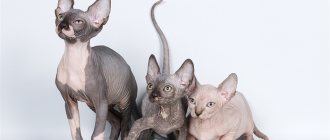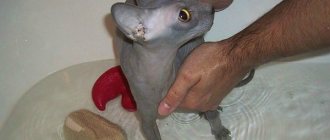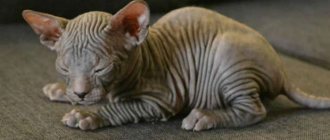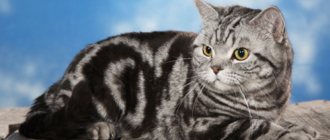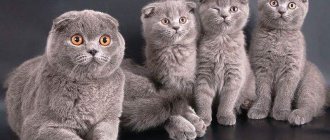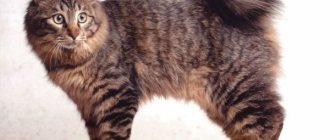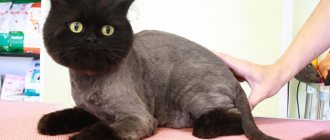Nowadays cats with a lack of hair will not surprise anyone. The current varieties of sphinxes evoke a smile, curiosity and a desire to touch the delicate skin of a hairless cat. But just twenty years ago, this breed evoked a mixture of horror and admiration.
Graceful animals with a mysterious look instantly captivated cat connoisseurs, and a boom swept across the planet, leading to the development of selective breeding. Attempts to breed a new species led to unexpected results.
By the way, these luxurious beauties are usually called not bald, but naked. Friendly pets with an exotic appearance have a good-natured character and an advantageous feature for people suffering from allergies is the lack of thick fur.
Skin and coat types of sphinxes
Only 4 types of sphinxes fit the description of hairless cats. The first of these to appear were representatives of the Canadian breed, whose targeted selection began in 1960. Although the name of these sphinxes cemented their affiliation with the Country of the Maple Leaf, the main experiments were carried out in the United States.
The mutation that led to the hair loss occurred naturally for unknown reasons. The Canadian Sphynx is born with fur, and then carries residual signs of it throughout its life. He only looks completely naked from afar. In fact, the thick skin is covered with fluff (up to 2 mm), and there is short hair on the bridge of the nose. Hair growth is also allowed on the inside of the ears, between the toes, on the belly and tail. To the touch, the skin of the Canadian Sphynx gives the impression of velor or velvet pile - an almost imperceptible gentle coating.
“Canadians” are born in this form and no significant transformations occur to them throughout their lives.
Another branch is the Don Sphynx, which was bred in Russia 20 years later. The hairlessness of this breed is due to a mutation of completely different genes and, although externally similar to the Canadian Sphynx, the domestic species has significant differences:
- there are Don Sphynxes with fur;
- As cats of this breed grow older, their external signs change.
Important! It is by the condition of the skin and the presence of overgrowth that experts can distinguish between these groups of cats. Moreover, this applies to all representatives, which also include Ukrainian Levkoys and Peterbalds (St. Petersburg sphinxes).
Hulborn
Such sphinxes have had no hair since childhood. Kittens of the Canadian breed may also have this sign, but later the body becomes covered with fluff. And the Don remain naked for the rest of their lives.
Naked with whiskers and eyebrows
The second type of naked-born. They can be born with no facial hair at all, or they can have mustaches and eyebrows. This sign is typical only for this group, and in all other cases, “woolen” sphinxes demonstrate all the signs that are provided for in the breed standard.
Flock
Rare wool that fits very tightly to the body. From a distance it is not even visible, but from a close distance it becomes noticeable. The faint fluffy coating on the skin feels like a delicate red dusting, like on peach fruits. Flock cats are often called velor cats, although in fact they are two different groups.
Sphinx velor
Externally, velor Sphynx cats are very similar to flock cats, but upon closer inspection and to the touch they are completely different. The fur of velor sphinxes is longer and thicker, but it lies tightly on the body and is therefore not visible at all. Depending on the color, this visual illusion behaves differently. The black velor Sphynx seems completely naked, but if you run your finger against the fur, you can feel the obvious resistance of the hair.
Soft brush
The description of the appearance of the Sphynx Brush breed may vary depending on which animal is in mind. The coat of Sphynx cats from this group is soft and slightly wavy.
Hard brush
The second group in the description of brush sphinxes has more elastic and springy hair. It curls and looks like lamb's wool. Grows longer than the coat of a soft brush.
Straight-haired
There are also very unusual sphinxes with fur. In terms of the quality of their coat, they are very similar to shorthaired cats. This species lingered in the group of hairless cats for the only reason - experts still haven’t figured out the mechanics of genetic mutation. Overgrown Sphynx cats with fur carry a mixed “cocktail” of traits that in the next generations can give rise to full-fledged rubber, flock, velor or brush kittens.
The appearance of sphinxes on Earth
The very first mentions of hairless Sphynx cats can be found in distant antiquity. Since ancient times, it has been believed that hairless cats existed among the Aztecs, and such a statement may well be true. And it all has to do with the fact that the Aztecs at one time bred hairless dogs.
Representatives of the ancient breed, which some time later was called the Mexican hairless cat, repeatedly shone at various exhibitions in the USA at the beginning of the 20th century. However, the very last couple of this breed lived only until the very beginning of the 30s and, unfortunately, never left any offspring, and that is why the history of Mexican hairless cats did not continue. In addition, the origin of this breed remains a mystery.
According to various descriptions, Mexican hairless cats differed significantly from modern representatives of the Canadian Sphynx breed.
Mexican hairless cats had a long body, their head was wedge-shaped with large amber eyes and incredibly long whiskers, which are not observed in the Canadian Sphynx. In winter, representatives of the Mexican breed suddenly grew long, and very thick, hair along their back and tail, which quickly disappeared by the beginning of summer. However, the genetic mechanism of such animal mutation remains undiscovered to this day. There is a high probability that Mexican hairless cats were genetically close to the Don Sphynx. This assumption is due to the fact that representatives of both of these breeds, although hairless, always had long mustaches, and by winter they grew long hair.
Petersburg brush (Peterbald)
Russian breed, in the selection of which Don cats took part. Just like their predecessors, these sphinxes are covered with curly hair and some of them remain in this form for the rest of their lives. The second half “undresses” not completely. In adult cats, dense growth is observed on the face, tail and may be on the paws. This option is called brush point due to the characteristic location of the hair at the ends of the body.
Canadian Sphynx (Sphynx) WCF standard
Body
Medium size, muscular, round, strong. At the same time, the skeleton is relatively elegant. The chest is wide, massive, the belly is rounded. The limbs also have a graceful structure, but the muscles are strong. The front legs are set wide due to the wide chest. Paws are oval, with long toes. The tail is long, thin, whip-shaped, without hair, but a tassel at the tip is allowed (lion tail).
Head : Medium size, slightly rounded modified wedge, not much longer than wide, with prominent cheekbones and a short, powerful, well-defined muzzle. Profile with transition. The neck is of medium length and muscular.
Ears: Very large, set wide apart, wide at the base, completely devoid of brushes. Slight pubescence at the base of the outer side of the ear is acceptable.
Eyes Large, lemon-shaped, set at a slight angle. The distance between them is slightly greater than the width of the eye. Eye color should be in harmony with skin color.
Wool The skin should have only minimal invisible fluff; it looks like the skin of a child. There is short pubescence on the muzzle; whiskers are desirable. The skin is clean, there are folds on the forehead, neck and limbs.
Color All colors are accepted, description is in the list of colors.
Disadvantages: Too much resemblance to both the Devon Rex and the Cornish Rex is a serious disadvantage.
Note: Crossing with other hairless breeds is prohibited.
SCORE:
body 35 head 30 eyes 5 hairless, folded 25 condition 5
total 100
Features of brush sphinxes
Why sphinxes grow hair remains a mystery to breeders and geneticists. No other features are noticeable in these animals. Physically, they are completely identical to naked and flocked, but in terms of character there may be discrepancies.
Don Brushes, like all other representatives of this breed of Sphynx cats, are friendly, curious and sociable. They are easy to train and get along well with other pets.
Peterbalds are related by blood to Oriental and Siamese cats. This genetic line not only conveyed the body structure typical of people from the Asian region, but also inherited character traits. St. Petersburg brushes sometimes become aggressive or offended. But this happens extremely rarely.
No other behavioral anomalies are observed in sphinxes of all breeds. People from different continents who have undergone natural mutations are very similar in behavior, habits and ability to communicate.
Advantages and disadvantages of plush sphinxes
The Sphynx with fur has many advantages:
- Lack of hostility, affection for the owner and an innate sense of kindness.
- Easy to learn, amenable to training.
- Lack of jealousy.
- Gets along very well with children and other pets.
- High degree of cleanliness.
- Cats are able to relieve pain and are considered medicinal.
Disadvantages include independence and self-sufficiency, as well as laziness and resentment.
Combining the pros and cons of the breed, it should be noted that, despite its bizarre appearance, interest in the breed is growing every year, gaining popularity. Grace and unrealistic look captivate millions of people.
Caring for curly brush cats
All sphinxes are in good health. They are not prone to disease, although they are very sensitive to temperature changes. It is enough for a cat to fall asleep in a draft or under air conditioning, and she is guaranteed to catch a cold. They can also sunbathe and get natural sunburn. It is best to avoid walking outdoors on hot days or lubricate the Sphynx's skin with baby cream.
Important! The folds on the Sphynx's skin require special attention. They need to be cleaned several times a week to prevent dirt from accumulating. In summer, cats may sweat, which becomes an additional source of skin irritation.
All sphinxes have an elevated body temperature and, as a result, an excellent appetite. Small cats try to eat a lot, but they almost never become obese - all calories are processed by active metabolism. The exception is castrated animals. For them, excess weight can become a serious problem.
Brushes are bathed 1-2 times a month, but often the unpleasant procedure is replaced by wiping the body with a wet towel. After washing, the cat should be dried, treated with cream on the skin folds and kept in a warm room for a while or wrapped in a blanket.
All Sphynx breeds are unique. Rarely does one encounter a group of animals whose characteristics are expressed by such similar criteria. Brushes in this list are in general positions with only one difference - the presence of fur makes them not the most typical representatives of their group and deprives them of the opportunity to receive champion titles at felinological exhibitions. But they perfectly maintain breeding qualities within breeds, take part in breeding and become parents of beautiful purebred hairless and flocked kittens. And for their owners they traditionally serve as faithful companions, ready to hang on every word of an authoritative owner.
How did the Canadian Sphynxes appear?
At a certain period of time, hairless kittens appeared in absolutely every corner of the world in the litters of ordinary animals. But then there were no attempts to cross at least two of these cats in order to create a completely new breed. For this reason, it is now difficult to say whether the Canadian Sphynx was a descendant of these animals, or the mutation of hairless breeds began anew, but now in 1966, when in Ontario, Canada, a hairless kitten was born to a great surprise from a normal domestic cat. The kitten was named Prune. When Prune grew up, he was bred with his mother, resulting in both normal and completely hairless kittens. And as long as it was possible, Prune was crossed with his own daughters and even granddaughters. All this was done only to preserve the original genes. As a result, two types of sphinxes appeared, which were slightly different in appearance.
Subsequently, the breeding of beautiful sphinxes suffered continuous failures, and there were many reasons for this.
Firstly, there were very few hairless animals, so there was no hope of stabilizing this breed at least a little. In addition, the breeders could not understand the genetics of the Sphynx.
Secondly, hairless kittens, unlike their counterparts, turned out to be very demanding to care for, and it was for this reason that many died almost immediately after their birth.
Well, thirdly, in the very first nurseries, breeders incorrectly developed a strategy for breeding a breed of hairless cats.
And if not for one incident, this could be the end of the story of hairless cats. However, in 1957, the story still had a continuation, because in Wadena, namely in the state of Minnesota, a simple short-haired cat gave birth to a hairless cat, who was named Epidermis. A year later, a completely hairless cat was born in the same state. Both hairless animals accidentally ended up in the same nursery called Z. Stardust. And it was in this nursery that Epidermis and this unknown bald female became the founders of the most elite breed of cats, the “Canadian Sphynx”.
In the late 70s, on one of the streets of Toronto, not far from the location of the very first hairless animals, three hairless kittens were found: two females and one black and white male, who was later named Bambi. Bambi's condition when he was found was simply terrible. His eye completely leaked out, but this is not the worst thing that happened to him, because when he was a little kitten, he required emergency surgery, during which Bambi had to remove his damaged testicles.
Two other small cats, who were named Pinky and Paloma, were almost immediately sent to Holland, where they became the founders of the classic European line of the Sphynx breed. After some time, in order to maintain the genetic pool of the Canadian Sphynx breed, cats began to be crossed not only with Sphynxes but also with Devon Rexes. It seemed that the choice of this breed for crossing was very successful, since their appearance was completely identical to the appearance of animals of the Canadian Sphynx breed. In addition, Devons turned out to be of natural origin, so when crossed with representatives of the Canadian Sphynx breed, hairless kittens were born in the first generation.
Such a huge influx of other blood, although of a genetically similar breed, was not in vain for the Canadian Sphynxes. Unfortunately, now you can find cats of the Canadian Sphynx breed, which have some similarities with bald Devons of a mediocre type: a very thin skin structure, a short “Devon” head with large and round eyes, which the Canadian Sphynx never possessed, ears set like in the Devonian, very low. A very characteristic feature of the very first animals of the Sphynx breed is wrinkled skin. Of course, the small kittens of this mysterious Sphynx breed still have wrinkled skin, but with age, the folds begin to diverge and remain only on the head or neck.
Source: https://dozoo.ru
What should a Sphynx owner do if he notices dark spots on his pet’s skin?
How to deal with stains?
If there are only a few spots on your pet’s body, they have just appeared, and you do not yet have the opportunity to contact a veterinarian (although you should not delay this), you can try using an aqueous solution of chlorhexidine to wipe them off. Of the special products, Tsamax and Laxis Zoo have proven themselves well. If spots appear on the skin, experts recommend putting soft clothing made from natural materials on sphinxes. Reducing exposure to air reduces the intensity of stains.
Why do cats need mustaches?
A cat's whiskers are sensory organs. Their correct name is vibrissae. Translated from Latin, this word means “to wriggle, waver.” With the help of whiskers, the cat receives additional information about the space around it.
The structure of the mustache is similar to ordinary hair, but it is thicker, stiffer, longer and “set” much deeper. If you look closely at any cat, you will find that “whiskers” grow on its cheeks, chin, eyebrows, and even on its front legs and tail.
Each vibrissa hair has an individual neural connection with the brain. They transmit data about the distance to nearby objects and record temperature changes. Whiskers help cats navigate in space, catch the movements of the prey, and accurately calculate the trajectory of the jump. With their help, the animal navigates in complete darkness.
The importance of vibrissae was confirmed during inhumane experiments to remove them.
Cats without whiskers felt worse:
- were clearly disoriented;
- their coordination of movements was impaired;
- could not correctly calculate the distance during a jump;
- “saw” worse in the dark;
- showed clear signs of stress.
For a domestic animal, the temporary loss of a mustache is not as tragic as for a free one. The life of a street cat depends on the ability to accurately navigate in space: to track and catch prey, to defeat an enemy in a fight, to run away and hide from the enemy.
All sphinxes are equally hairless
The first modern hairless kitten was born to a Canadian cat in 1966. The breeders became interested in the original cat and did everything possible to continue the breed. And in the late 80s, the first hairless cat was born in Rostov-on-Don, becoming the founder of the Don Sphynx family.
At the same time, St. Petersburg felinologists developed the Peterbald breed, independently of their Rostov colleagues. All three varieties have not only external, but also emotional differences. The Canadian Sphynxes are considered the calmest and friendliest, distinguished by their rounded ears and smooth lines. The Don Sphynx has a more elongated and sharply defined muzzle, while Peterbalds are distinguished by the greatest sophistication, huge ears and elongated proportions.
In addition, each breed has acceptable coat options - from completely bald “rubber” cats without mustaches and eyebrows to those covered completely or partially with hair of different lengths. It's funny that at first they tried to treat the first-born Sphynx cubs for lichen, until they realized that the lack of hair was a normal feature of their body.
Petersburg Sphynx (Peterbald)
The breed was bred in St. Petersburg in 1994. Baldness is based on a recessive gene. The ancestors of the species were the Don Sphynxes. This breed is distinguished by an elegant, slender appearance, an elongated muzzle with oval eyes and huge ears set apart to the sides.
In addition to animals without hair, Peterbalds, like the Don Sphynx, have varieties of individuals with wool: brush, velor, flock, straight-haired. Let's focus on the last variety, since the previous types were considered in the review of the Don breed.
Where is the best place to buy a Sphynx kitten?
Those who decide to get a Sphynx should definitely contact professional breeders. By purchasing a kitten at a club or at an exhibition, you can avoid problems with the health of the animal and receive guaranteed lifelong information support and support from experts in the breed.
Club Sphynx
If you still doubt whether you should have a Sphynx at home, answer yourself one question: “Do you want to get a reliable, faithful friend who does not remember insults, will be devoted to you, and will never turn away?” If the answer is yes, feel free to cast aside all doubts and take a step towards a small bald miracle.
Video: All about Sphynx cats
Source
Nowadays cats with a lack of hair will not surprise anyone. The current varieties of sphinxes evoke a smile, curiosity and a desire to touch the delicate skin of a hairless cat. But just twenty years ago, this breed evoked a mixture of horror and admiration.
Graceful animals with a mysterious look instantly captivated cat connoisseurs, and a boom swept across the planet, leading to the development of selective breeding. Attempts to breed a new species led to unexpected results.
By the way, these luxurious beauties are usually called not bald, but naked. Friendly pets with an exotic appearance have a good-natured character and an advantageous feature for people suffering from allergies is the lack of thick fur.
Why does the Sphynx begin to grow hair?
Kittens and adult Sphynx cats sometimes begin to grow hair. There may be several reasons.
- Cold weather.
With the onset of cold weather, most sphinxes are covered with short fluff; in some areas of the body the hair can be quite long. It can grow back even if it only got cold outside the window, but the temperature in the house was always maintained at a comfortable level. - Heredity.
Canadian Sphynxes are the most stable breed. The appearance of fur on them usually indicates the “sins” of the breeder and accidental interbreed matings. You can expect everything from Donetsk, Peterbald, Levkoy and other hairless breeds. They are on the path of becoming. It happens that kittens do not shed their fur and this cannot be predicted, and adult cats can grow and remain fluffy. - Hormonal changes.
Wool can grow rapidly or, on the contrary, fall out as a result of puberty, pregnancy, castration/sterilization, disruption of the endocrine system and other factors affecting the general hormonal balance.
Observations show that reasons such as feeding, illness, stress in combination with the above can affect the amount of hair in a hairless cat.
Regardless of the amount and length of the sphinx's fur, the character and habits usually do not change. Even in their fluffy form, they remain very gentle and sociable creatures who adore warmth and comfort.
Characteristic features of the head
The head of the Canadian Sphynx does not exceed the size of the body, but, on the contrary, is harmoniously combined with it. Slightly extended forward, it has a wedge-shaped shape. The rounded skull of the Sphinx is flat at the front and its length exceeds its width. At first glance, the nose of the Canadian Sphynx is absolutely straight, but if you look closely, the transition of the nose to the forehead has a small depression. The rounded muzzle of the Sphinx has clearly defined cheekbones, the pads of the mustache and a rather powerful chin stand out very clearly. The head smoothly merges into the neck, which is not very long, muscular and slightly arched from the shoulders. A characteristic feature of an adult Sphynx is its fairly developed muscles.
Character
These two cat breeds also differ in character and behavior.
Sphynx cats are very independent and self-sufficient and can be naughty at times. These cats consider themselves full members of the family, and therefore require respectful treatment. Another feature of these cats is their touchiness. If you shout at a pet or punish it, it will definitely take revenge on its owner as soon as the opportunity arises.
Hairless cats from Rostov, on the contrary, are more docile and friendly, and are sincerely attached to their owner. They are very smart, and unlike their Canadian counterparts, they quickly remember what is allowed and what is strictly prohibited. Even if you scold your pet for some prank, he will not take revenge, but with a guilty look will try to beg forgiveness from the owner.
These cats also treat strangers differently. Canadians, as a rule, are distrustful and suspicious, so they will try to hide from guests in a secluded corner. He is friendly and sociable and enjoys meeting new people, even allowing himself to be petted or picked up.
The Donetsk people have another interesting difference from their Canadian relatives. While Canadian males are not at all interested in their own offspring, leaving females to take care of their offspring, male Don Sphynxes are very kind to their babies and help their hairless “wives” look after the kittens.
Don Hairless cats will get along well with other pets and will not be jealous of their owner. Canadians are extremely jealous and will not tolerate other animals receiving more attention than themselves.
Russian Sphynxes are distinguished by good health and endurance, but Canadian ones cannot boast of the same. Sphynxes from Canada are susceptible to colds and do not tolerate cold and drafts well.
At the same time they are similar to each other, and at the same time very different. But it doesn’t matter at all which sphinx – the Don or the Canadian – is preferred. Much more important is that any pet needs care, attention and care, and this should never be forgotten.
Sphynx cats are perhaps the most unusual representatives of the domestic cat kingdom. They seem to be some kind of alien creatures. There are many misconceptions about them that need to be addressed.
